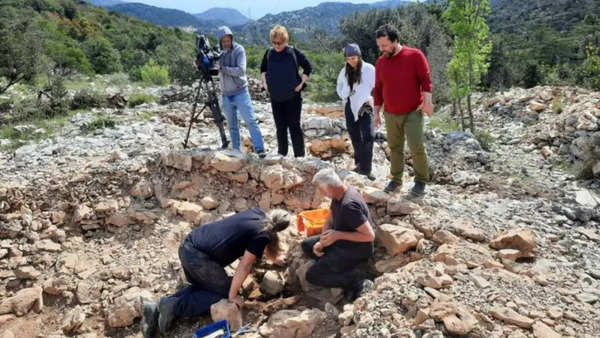The Greek-Illyrian helmet, dating back to the 6th century BCE, was discovered in a walled addition to a grave, suggesting it may have been left as a votive offering. Such helmets were symbols of status and power, often associated with the warrior elite of the time. The discovery of two different types of helmets in the same location speaks volumes about the continuity of power within the respective community and the significance of these artifacts in ancient funerary practices.
Professor Hrvoje Potrebica from the Department of Archaeology at the Faculty of Philosophy in Zagreb, who led the excavation, expressed the importance of the find: “These helmets have always been a symbol of some kind of status and power,” highlighting the role such objects played in the social and political landscape of ancient Illyrian communities.

The helmet was discovered by a team led by Professor Hrvoje Potrebica from the Department of Archaeology at the Faculty of Philosophy in Zagreb. Source: Dubrovnik Museum
The Greek-Illyrian helmets originated in the Peloponnese region of Ancient Greece and evolved from the Kegelhelm of the Archaic Period. The helmet found in 2020 was of a type commonly used in Greece and Illyria in the 4th century BCE, characterized by an open face and decorative edges. In contrast, the newly discovered helmet is believed to be even older, dating from the 6th century BCE, and is considered extremely rare.
The discovery has been hailed as unprecedented, as finding two different Greek-Illyrian helmets at one site is a first of its kind. This find, along with other artifacts such as jewelry, costumes, and grave goods unearthed since the excavations began, greatly expands our knowledge of the funeral practices of Illyrian communities in the latter half of the first millennium BCE. It also ranks the area of Pelješac as one of the most important archaeological zones of the eastern Adriatic coast.
A representative from the Dubrovnik Museum highlighted the significance of the helmet, stating, “This find of a helmet contributes in many ways to the knowledge of funeral rituals of Illyrian communities in the second half of the last millennium BCE,” further emphasizing the cultural and historical value of such discoveries.
The excavation team’s efforts have not only brought to light a piece of history but have also sparked a conversation about the ancient world’s interconnectedness. The helmets’ design and craftsmanship reflect a blend of Greek and Illyrian styles, indicating a cross-cultural exchange that was prevalent in the ancient Mediterranean world.
As the study of the helmet and its context continues, researchers hope to uncover more about the people who once wore these helmets, their lives, and the societies they built. Each artifact like the Greek-Illyrian helmet serves as a puzzle piece in reconstructing the vast puzzle of human history. This discovery gives us meaningful insight into the inner workings of ancient civilizations that once thrived in the Balkans and their contribution to the cultural heritage of humanity.







